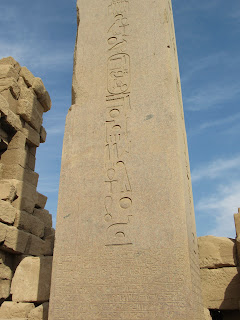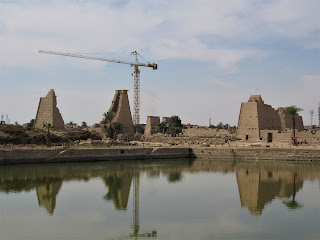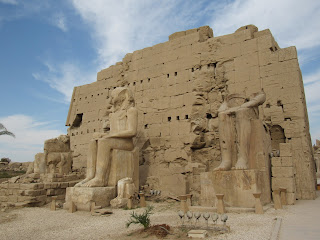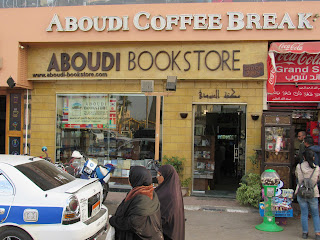Sunset over the Nile
This the post I've been dreading writing (well, this one and the one to follow). It isn't because of any terrible experiences we had while in Luxor; on the contrary, it was a wonderful time. The reasons for putting off finishing this post are twofold: 1) there were too many photographs to sift through, select and then upload; and 2.) Luxor ("the world's greatest open air museum") is such an amazing place that someone with my poor writing skills can't even begin to adequately describe the sights to see there. Nevertheless I'll give it a try, though laziness will probably result in my letting the many photos to follow tell the story themselves.
The second day of January turned out to be a glorious one, weather-wise. This was the view from our hotel looking across the Nile toward the west bank:
The west bank, however, would be reserved for the next day. On this day, we stayed on the east bank of the Nile, first taking a taxi to the incredible Karnak complex. The site is spread out over 2 square kilometers and was constructed and altered over a period of 1500 years, dominated by the Temple of Amun-Ra. Joining the hordes of tourists arriving in groups on buses, we plunged in, starting with the avenue of ram-headed sphinxes:
Standing inside the Great Court:
The Great Hypostyle Hall is a forest of 134 stone pillars. Each summer when the Nile flooded, the hall would fill with several meters of water:
The Obelisk of Hatshepsut:
Great Festival Hall of Tuthmosis III:
Throughout our stay in Egypt, I tormented by daughter with an endless series of terrible Dad jokes based around the old Bangles hit "Walk Like an Egyptian":
The sacred lake:
Giant Scarab:
The Fallen Obelisk of Hatshepsut:
My wife consents to be photographed (sort of):
Inside the Temple of Khonsu:
Amber noticed this bird resting in an opening on one of the pillars:
The Euergetes' Gate, beyond which is an avenue of sphinxes leading to Luxor Temple:
I say this is a baboon; Shu-E maintains it's a ram. You make the call:
The Open-Air "Museum" is a collection of shrines, statues and stones:
By the time we emerged from Karnak, the tour groups were gone and the entrance was surprisingly quiet. If you're planning on visiting, wait until after lunchtime to avoid the crowds:
Looking towards the hills of the west bank:
Lunch was barbecued chicken in front of the complex. Delicious, but overpriced - best to eat back in town:
Speaking of which, we returned by taxi to the central part of Luxor and did some souvenir shopping at a shop where the prices were fixed. A relief for me as I hate haggling; my wife, being Taiwanese, is much more experienced in the fine art of bargaining, though she's not even close to her mother when it comes to the back-and-forth of getting a better deal:
The central part of Luxor is home to the Luxor Temple (which we would visit in the evening) and the Luxor Museum (which we passed on after having visited the Egyptian Museum the previous day):
Luxor street scene. After the utter cacophony and chaos that is Cairo, the traffic was relatively light in Luxor:
The sheer number of English-language volumes on sale in the Aboudi Bookstore was almost enough to convert me into an Egyptologist:
Amber and Shu-E were amused by the pairing of ROC and PRC flags in this shopfront:
The Nile and west bank from Luxor's corniche:
The Winter Palace Hotel is one of Egypt's most famous accommodations, a relic of an earlier age:
The sun setting over the Nile, a truly beautiful sight:
With darkness enveloping, we visited Luxor Temple, which stays open until 2100 hours. The aforementioned Avenue of Sphinxes:
I'm sure the temple is a stunning sight in the daylight hours, but visiting after sunset was the right decision:
The 14th-century Mosque of Abu Al Haggag adjoins the southeastern side of the temple complex:
The complex is defined by the Great Court of Ramses II:
The Baroque Shrine of Amun lies at the end of the temple:
Pretending like I know the meaning of the enscriptions:
Afterward we walked briefly through a shopping street, deflecting the constant stream of invitations to go inside the shops and look around:
It would be difficult to top the splendors on the east bank side of the Nile, but the west bank was yet to come...
My apologies, but it had to be shared at some point in this blog series:























































































































No comments:
Post a Comment